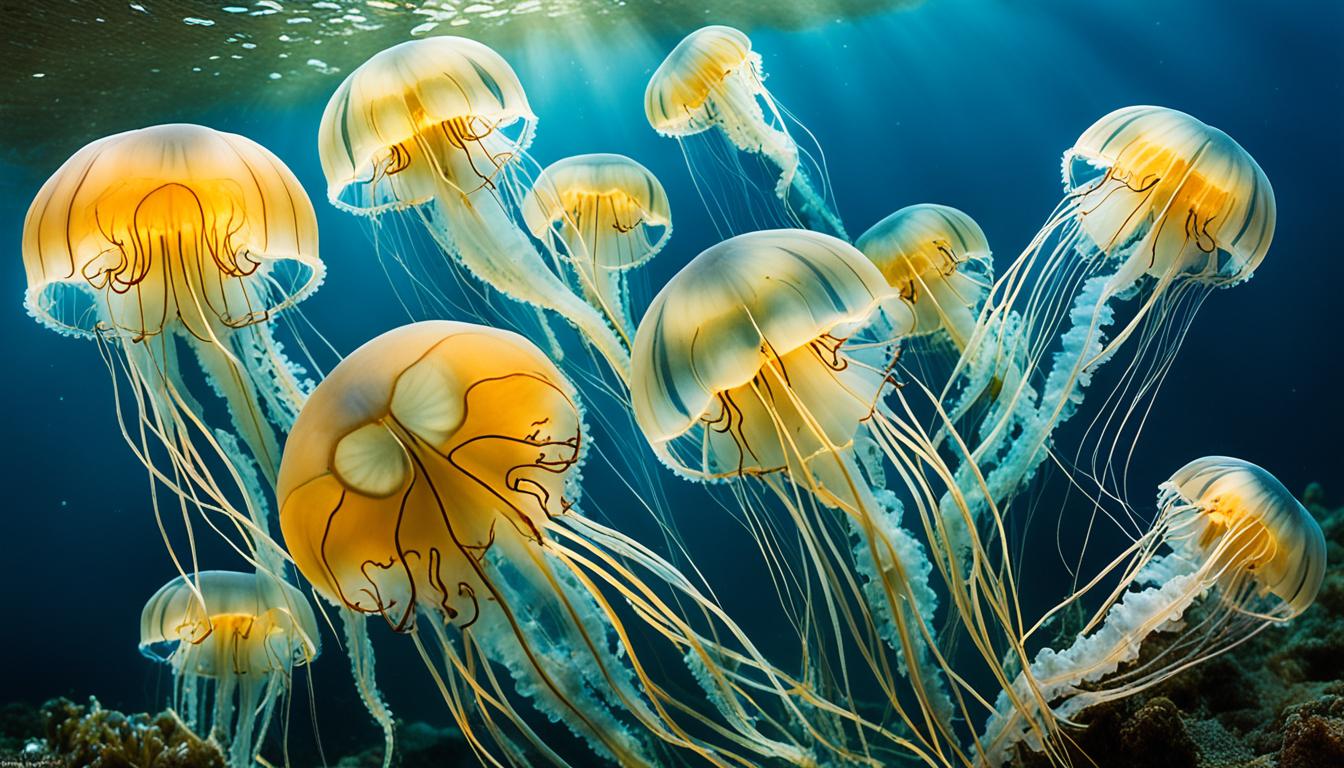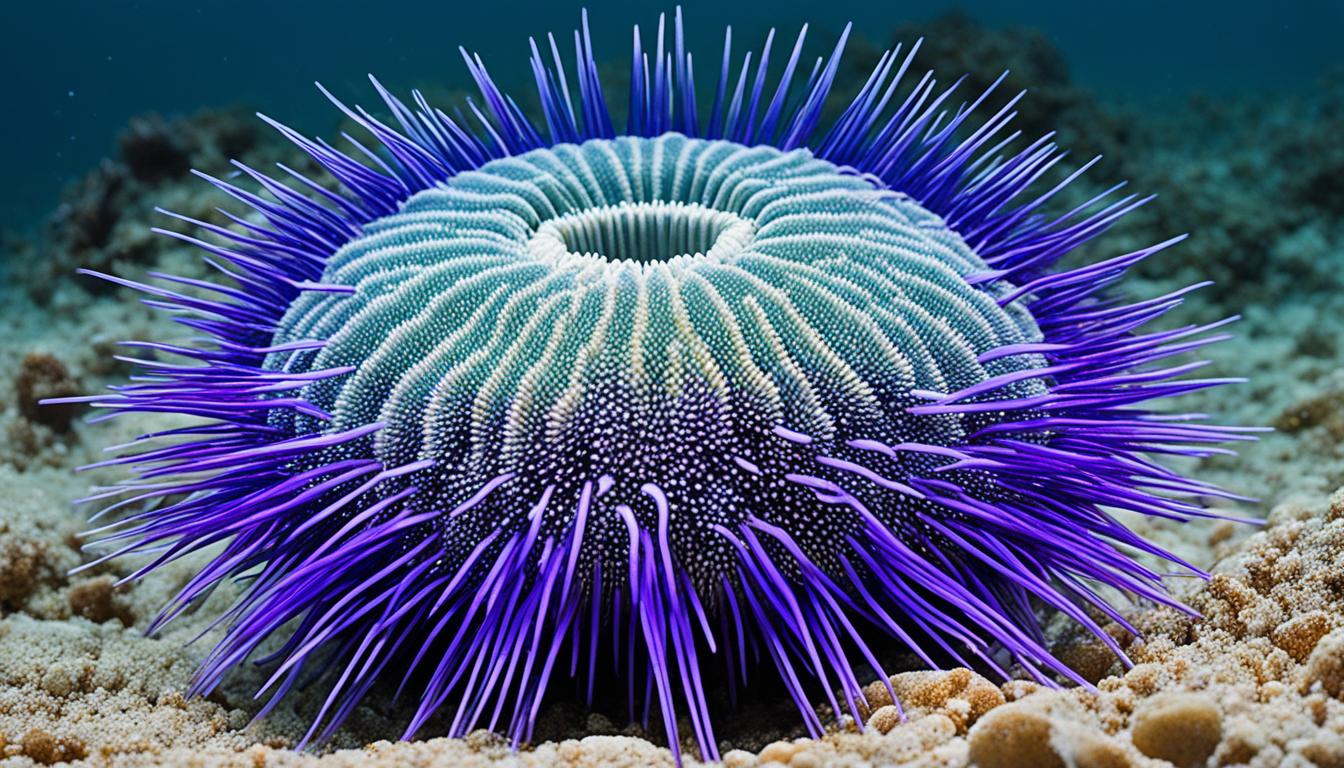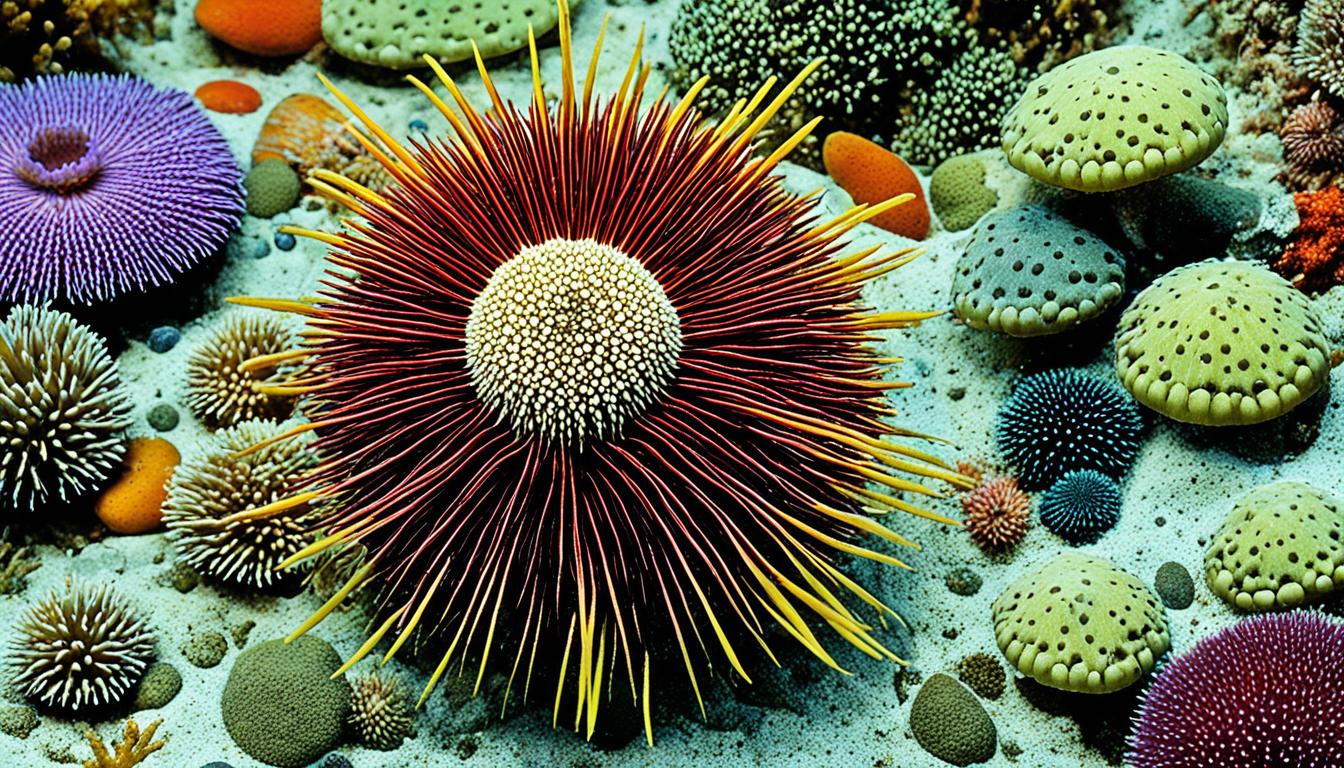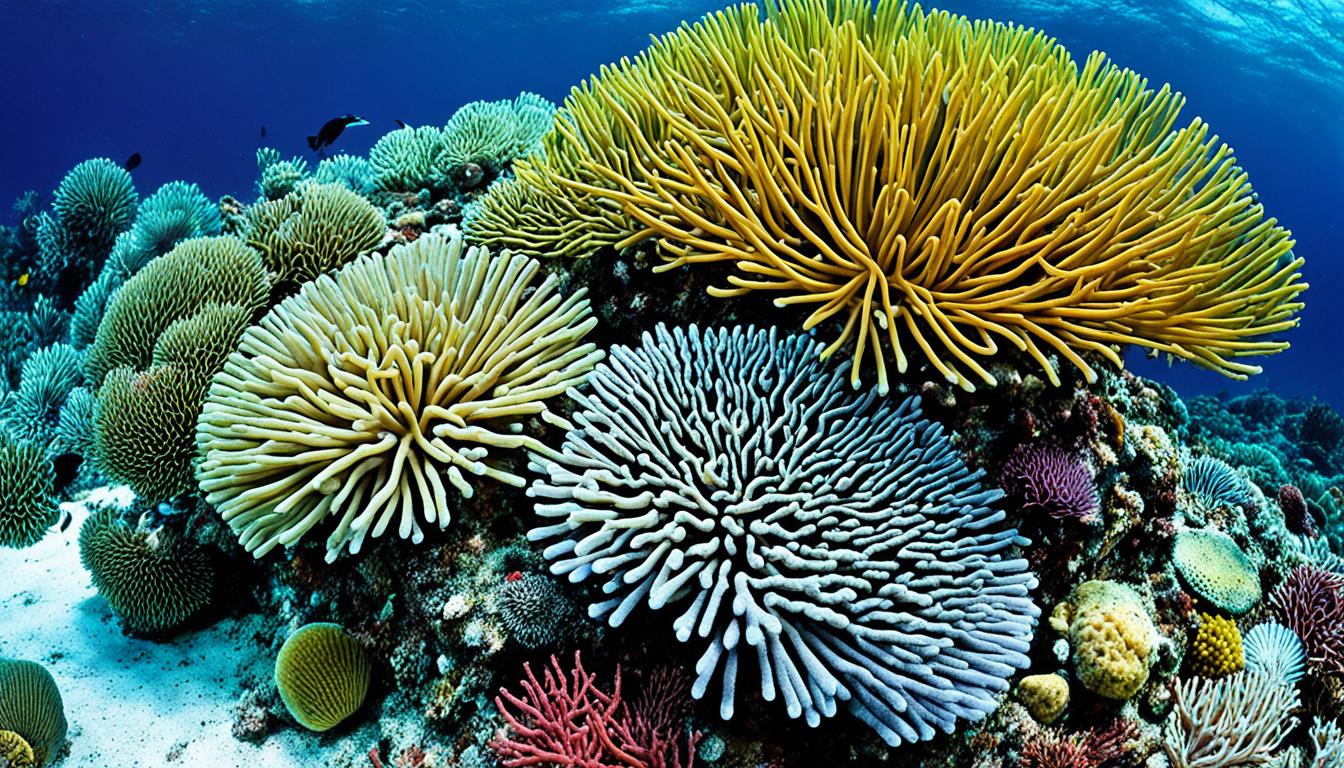Welcome to the enchanting world of jellyfish. Here, you’ll explore the most common jellyfish species found in our oceans. These creatures, with their delicate and see-through bodies, are key to marine life. As you learn more about them, you’ll see how they live, where they live, and why they matter.
Knowing about jellyfish diversity helps us appreciate ocean life more. It also shows us how they help keep the ocean healthy.
Introduction to Jellyfish Diversity
Jellyfish show a wide variety of life in the ocean, with over 200 known species. Each one has its own special traits and ways of surviving. Knowing about the types of jellyfish helps us understand their role in the sea.
These creatures come in many shapes and sizes, showing how they’ve changed over time. They move through the water with a unique pulse, looking both elegant and efficient. You can find them in shallow coastal areas and deep in the ocean, each type living in its own way.
Looking into jellyfish diversity teaches us about their biology. Each kind has its own body parts and ways to survive in its home. By learning about these species, we see how important they are to the ocean and the beauty they bring to it.
| Type of Jellyfish | Habitat | Key Characteristics |
|---|---|---|
| Moon Jellyfish | Coastal waters | Translucent bell, short tentacles |
| Box Jellyfish | Tropical regions | Cube-shaped bell, potent venom |
| Sea Nettle | Atlantic Ocean | Long tentacles, distinctive patterning |
What are the most common jellyfish species?
Exploring the ocean shows us many common jellyfish species. They live in various places. Knowing about these species helps us understand their roles in the ocean.
Overview of Their Habitats
These jellyfish live in different places, from shallow coastal waters to deep ocean. Each type has adapted to its own environment:
- Moon Jellyfish (Aurelia aurita): Loves warm coastal waters and can be found in estuaries.
- Box Jellyfish (Chironex fleckeri): Found in tropical coastal waters, especially in northern Australia.
- Sea Nettle (Chrysaora fuscescens): Lives in the Atlantic and Pacific Oceans, near the coast.
Significance in Marine Ecosystems
Jellyfish are more than just pretty to look at. They are key to the ocean’s food web:
- They feed many marine animals, like sea turtles and some fish.
- They help keep prey populations in check, keeping their homes balanced.
- They play a part in nutrient cycles, which affects ocean health.
| Jellyfish Species | Habitat Type | Marine Ecosystem Role |
|---|---|---|
| Moon Jellyfish | Coastal waters, estuaries | Food source, nutrient cycling |
| Box Jellyfish | Tropical coastal waters | Prey regulation, habitat indicator |
| Sea Nettle | Atlantic and Pacific Oceans | Prey for larger species, ecological balance |
Popular Jellyfish Types in the Oceans
When you explore the ocean, you’ll meet many jellyfish types. Each one has unique traits that set it apart. Knowing about these types helps with identifying them and understanding their role in the ocean.
Moon Jellyfish (Aurelia aurita)
The Moon Jellyfish, or Aurelia aurita, is easy to spot with its bell-shaped, clear body. It floats in coastal waters. These jellyfish have mild venom, so they’re safe for swimmers. Their looks and role in the food chain are key to their importance.
Box Jellyfish (Chironex fleckeri)
The Box Jellyfish, or Chironex fleckeri, is known for being very venomous. It lives in northern Australia and Southeast Asia’s coastal waters. Swimmers should be careful around this jellyfish because of its strong venom and unique shape.
Sea Nettle (Chrysaora fuscescens)
Sea Nettles, or Chrysaora fuscescens, are found along the East Coast of the U.S. and in the Gulf of Mexico. They have beautiful colors and a sting that’s not too bad. Their size and looks help with identifying them in the ocean.
| Jellyfish Type | Scientific Name | Venom Level | Habitat |
|---|---|---|---|
| Moon Jellyfish | Aurelia aurita | Low | Coastal waters |
| Box Jellyfish | Chironex fleckeri | High | Tropical coastal waters |
| Sea Nettle | Chrysaora fuscescens | Moderate | East Coast, Gulf of Mexico |
Unique Characteristics of Jellyfish Species
Jellyfish are fascinating creatures with a gelatinous body. They have a bell-shaped umbrella that lets them move easily through the water. Underneath, they have tentacles with cells called cnidocytes that help them catch food. Jellyfish don’t have complex organs like other sea creatures, showing how simple yet effective they are in the ocean.
Structure and Anatomy of Jellyfish
Jellyfish have an interesting structure. Their soft, transparent bodies might look fragile, but they have special features for survival. The bell shape helps them swim smoothly. The tentacles have stinging cells to catch food and defend against predators. Here’s a look at their main body parts:
| Feature | Description |
|---|---|
| Bell | Gelatinous and umbrella-like, aiding in movement |
| Tentacles | Armed with stinging cells for capturing prey |
| Mesoglea | Thick, jelly-like layer providing support |
| Oral arms | Help in the ingestion of food |
Diverse Venomous Ratings
Jellyfish have different levels of venom, affecting their role in the ocean. Some are harmless to humans, while others can be very dangerous. It’s important to know this when exploring the sea. Here’s a quick look at some jellyfish and their venom levels:
| Jellyfish Species | Venomous Rating |
|---|---|
| Moon Jellyfish | Low – Generally harmless |
| Box Jellyfish | High – Extremely dangerous |
| Sea Nettle | Moderate – Painful stings possible |
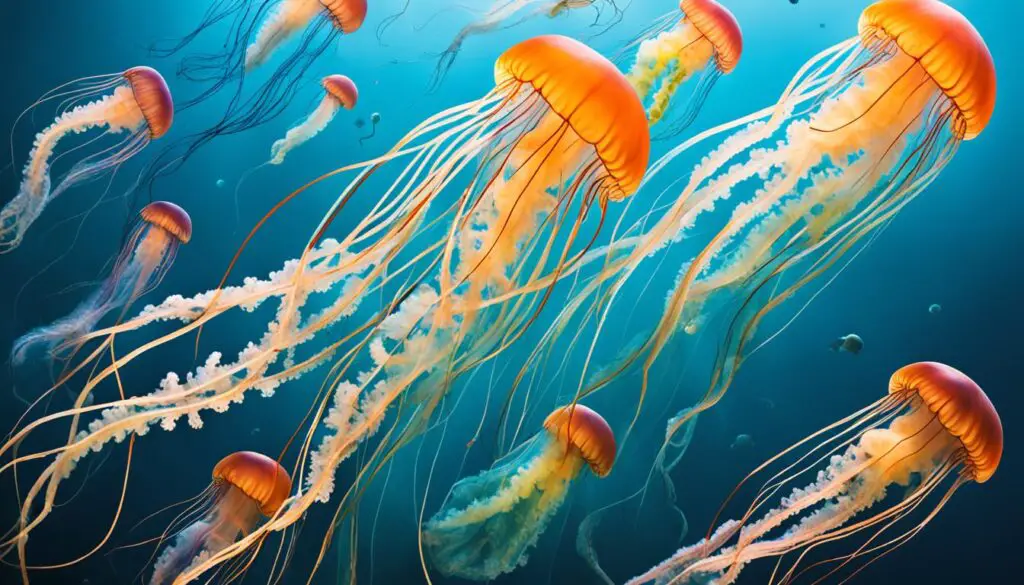
Habitat of Common Jellyfish
Jellyfish live in many places, showing how they survive and spread out. Each type of jellyfish has its own special place to live. They adapt to their environments in amazing ways.
Coastal Waters vs. Open Ocean
Coastal waters are full of nutrients and food, making them perfect for jellyfish like the moon jellyfish. But, open ocean jellyfish live in places with less food and face other challenges.
- Coastal Jellyfish: Thrive in shallower waters, benefiting from sunlight and nutrient runoff.
- Open Ocean Jellyfish: Adapt to deeper, darker waters where nutrient levels are consistently lower.
Environmental Factors Influencing Distribution
Many things affect where jellyfish live. Things like salt levels, water temperature, and food availability are key. These factors help decide where you can find jellyfish.
| Environmental Factor | Coastal Jellyfish | Open Ocean Jellyfish |
|---|---|---|
| Salinity | More stable and variable | Constant and often higher |
| Water Temperature | Warmer in shallow areas | Colder, particularly at greater depths |
| Nutrient Availability | High due to runoff and upwelling | Low, often relying on less diverse food sources |
These factors greatly impact how jellyfish breed and find food. They affect their numbers and where they live in different places.
Classifying Jellyfish: Understanding Types of Jellyfish
Jellyfish come in many species and types, showing their rich diversity. Classifying them helps us understand their differences, which is key for science and nature. We see big differences between true jellyfish and hydrozoans that help us tell them apart.
True Jellyfish vs. Hydrozoans
True jellyfish have a jelly-like umbrella shape and tentacles with stinging cells. They can swim freely and vary greatly in size. Hydrozoans, however, have a polyp stage and look more like plants. They are different from true jellyfish but both are important in the ocean.
Biological Classification Insights
Studying jellyfish helps us learn about their past and how they fit into nature. Scientists use looks and genes to sort jellyfish into groups. This helps us understand their lives, where they live, and how they interact with the ocean.
Ecological Role of Jellyfish in Marine Life
Jellyfish are key to keeping marine ecosystems in balance. They come in many types and affect the food chain and biodiversity. Their impact helps keep marine habitats healthy and supports the food web.
Food Chain Dynamics
Jellyfish have a big role in the food chain. They are eaten by big marine animals like fish and sea turtles. This helps control the numbers of jellyfish and their predators. The effects of these interactions change the population sizes of many species.
- Primary consumers of jellyfish include:
- Sunfish
- Turtles
- Certain species of fish
- Jellyfish also compete with other sea creatures for resources, affecting marine ecosystems.
Contribution to Marine Biodiversity
Jellyfish add to marine biodiversity in many ways. They are homes for small sea creatures, making ecosystems richer. Many species rely on jellyfish for shelter and food, creating a diverse life in these places.
| Type of Contribution | Description |
|---|---|
| Habitat Provision | Jellyfish create homes for small fish and invertebrates. |
| Nutrient Cycling | Decaying jellyfish give nutrients to the ecosystem, helping plants and animals. |
| Prey and Predator Relationships | Jellyfish are eaten by some and eat others, affecting many species’ populations. |
How to Identify Common Jellyfish Species
Identifying jellyfish starts with looking at their physical traits. Species like the Moon Jellyfish and Box Jellyfish have unique bell shapes. These shapes are key to telling them apart. The Moon Jellyfish has a clear, umbrella-like bell with soft colors. The Box Jellyfish has a square bell that might look pale blue.
Color is also key in identifying jellyfish. For instance, the Sea Nettle stands out with its bright orange or brown color. It’s different from the Moon Jellyfish’s duller colors. Size also varies greatly among jellyfish, from tiny to big. This helps when you’re swimming or exploring the beach.
Learning about these features deepens your understanding of jellyfish. It also makes you appreciate these marine animals more. As you get better at spotting them by their looks, your ocean adventures will become more exciting. You’ll learn more about the ocean’s diverse life.

